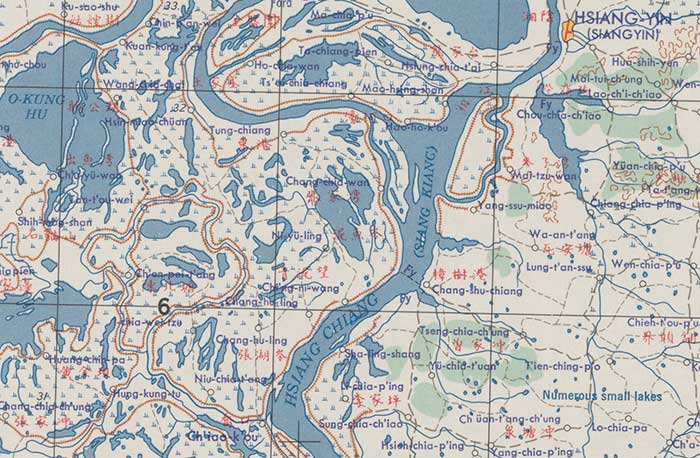View Metadata
World Air Temperature Distribution in January (polygon), 1996
- Identification Information
- Data Quality Information
- Spatial Data Organization Information
- Spatial Reference Information
- Entity and Attribute Information
- Distribution Information
- Metadata Reference Information
- Identification Information
- Citation
- Originator
- Environmental Systems Research Institute (Redlands, Calif.)
- Publication Date
- 1996
- Title
- World Air Temperature Distribution in January (polygon), 1996
- Geospatial Data Presentation Form
- vector digital data
- Series Information
- Series Name
- ArcAtlas
- Publication Information
- Publication Place
- Redlands, Calif.
- Publisher
- ESRI
- Online Linkage
- https://www1.columbia.edu/sec/acis/eds/dgate/studies/C1301/data/esri_1996_world_jantemppoly.zip
- Abstract
- World Air Temperature Distribution in January (polygon), 1996 is a polygon theme representing the distribution of air temperatures in January worldwide.
- Purpose
- For educational, non-commercial purposes. This dataset is appropriate for use in a GIS.
- Supplemental Information
- Air temperature near the earth's surface is a major climatic factor controlling the environment and significantly influencing the quality of human life. The temperature of the air near the ground is mostly a result of heat exchange with the ground. It depends on two main factors: solar radiation and ground characteristics. The amount of solar radiation received by a place on the earth varies with latitude and with season. Annual solar radiation increases from the high latitudes (poles) to the low latitudes (tropics). Solar radiation varies seasonally with sun altitude. The proportion of solar radiation absorbed by the ground is the most important characteristic influencing the how much the ground heats the surrounding air. The proportion of absorbed solar radiation ranges from 10 percent for dry, clean, cold snow to 90 percent for water. For example, the proportion of absorbed radiation is about 78 to 86 percent for vegetation, 70 to 75 percent for desert sand, and 10 to 60 percent for snow, depending on its moisture and dust contents. The air temperature of a region is influenced by regional heat exchange and air masses transferred to the region by atmospheric circulation. Land and water have different thermal characteristics. Land heats and cools more readily than water, so the continents are warmer in summer and cooler in winter than the oceans. Because the characteristics of air masses are formed by heat exchange along their routes, atmospheric circulation pattern over continents and ocean is also a leading factor determining air temperature. Large ice covers, such as in Antarctica, the Arctic, and Greenland, also influence the character of the air masses over them. Ocean currents are another factor that influence air temperature. The ocean currents affect the temperature of the air masses that pass over them. Air mass routes go westward between 30 and 75 degrees latitudes, and eastward at latitudes above 75 degrees and below 30 degrees in both the northern and southern hemispheres. Air temperatures on the windward sides of the continents are similar to the temperatures of the ocean air masses because they are not yet modified much by the temperature of the land. These areas are said to have maritime climates. In the interiors and the leeward sides of continents, air temperatures are significantly modified by the ground. These areas are said to have continental climates. Continental climates are characterized by great annual temperature range, that is, a great difference between summer and winter temperatures. The range also increases with increasing latitude. In contrast, maritime climates are characterized by cool summers and mild winters. Altitude also controls air temperature. Air temperatures generally decrease with altitude for two reasons: (1) increasing distance from the greatest surface area of the ground, which is the air's heat source, and (2) the natural expansion and cooling of the air as it rises, which results from the thinning of the atmosphere with altitude. The change in temperature with altitude (the vertical temperature gradient) is greater for dry air than for moist air. The rate of change averages 0.8 degrees Celsius per 100 meters of altitude. It is less in humid climates, 0.5 degrees per 100 meters, because as the rising air cools, water condenses and heat is released, slowing the rate of cooling. Air temperatures decrease at rates close to the average gradient in summer, but in winter, the decrease is often broken by a temperature inversion. An inversion occurs when cold dense air accumulates near the cold ground and warmer air is found above it, causing the normal vertical gradient to be reversed. Mountains can be barriers to air masses. As a result, their altitudes and directions have an effect on a region's air temperatures and atmospheric circulation.
- Temporal Extent
- Currentness Reference
- publication date
- Time Instant
- 1996
- Bounding Box
- West
- -180
- East
- 180
- North
- 85
- South
- -85
- Theme Keyword
- climatologyMeteorologyAtmosphere
- Theme Keyword Thesaurus
- ISO 19115 Topic Categories
- Theme Keyword
- Temperature
- Theme Keyword Thesaurus
- None
- Place Keyword
- Earth
- Place Keyword Thesaurus
- Library of Congress Subject Headings
- Temporal Keyword
- 1996
- Temporal Keyword Thesaurus
- None
- Access Restrictions
- For current Columbia affiliates only.
- Use Restrictions
- For educational, non-commercial use only.
- Status
- Complete
- Maintenance and Update Frequency
- None planned
- Point of Contact
- Contact Organization
- ESRI
- Delivery Point
- 380 New York Street
- City
- Redlands
- State
- California
- Postal Code
- 92373-8100
- Country
- USA
- Contact Telephone
- 909-793-2853
- Contact Facsimile Telephone
- 909-793-5953
- Contact Electronic Mail Address
- info@esri.com
- Hours of Service
- 7:00 a.m.-5:30 p.m. Pacific time, Monday Friday
- Native Data Set Environment
- Microsoft Windows XP Version 5.1 (Build 2600) Service Pack 3; ESRI ArcCatalog 9.3.1.1850
- Data Quality Information
- Lineage
- Source
- Originator
- Department of National Development
- Publication Date
- 1952
- Title
- Atlas of Australian Resources. First Series.
- Geospatial Data Presentation Form
- atlas
- Publication Information
- Publication Place
- Canberra
- Publisher
- Department of National Development
- Type of Source Media
- paper
- Source
- Originator
- WHO, UNESCO, USSR Goskomgidromet, UNEP
- Publication Date
- 1981
- Title
- Climatic atlas of Asia
- Geospatial Data Presentation Form
- atlas
- Publication Information
- Publication Place
- Leningrad
- Publisher
- Gidrometeoizdat
- Type of Source Media
- paper
- Source
- Originator
- WHO, UNESCO, Cartographia. Technical supervisor F.
- Publication Date
- 1970
- Title
- Climatic atlas of Europe
- Geospatial Data Presentation Form
- atlas
- Publication Information
- Publication Place
- Budapest
- Type of Source Media
- paper
- Source
- Originator
- WHO, UNESCO, Cartographia.
- Publication Date
- 1979
- Title
- Climatic atlas of North and Central America
- Publication Information
- Publication Place
- Budapest
- Type of Source Media
- paper
- Source
- Originator
- WHO, UNESCO, Cartographia. Budapest
- Publication Date
- 1975
- Title
- Climatic atlas of South America
- Geospatial Data Presentation Form
- atlas
- Type of Source Media
- paper
- Source
- Originator
- Lebedev, A. N.
- Publication Date
- 1978
- Title
- Klimaticheskiy atlas Afriki
- Geospatial Data Presentation Form
- atlas
- Publication Information
- Publication Place
- Leningrad
- Publisher
- Gidrometeoizdat
- Type of Source Media
- paper
- Source
- Originator
- Parkinson, G., and Thompson, C.J.
- Publication Date
- 1986
- Title
- Atlas of Australian Resources
- Geospatial Data Presentation Form
- atlas
- Publication Information
- Publication Place
- Canberra
- Publisher
- Commonwealth Government printer
- Type of Source Media
- paper
- Spatial Data Organization Information
- Direct Spatial Reference Method
- Vector
- Point and Vector Object Information
- SDTS Terms Description
- SDTS Point and Vector Object Type
- G-polygon
- Point and Vector Object Count
- 3700
- Spatial Reference Information
- Horizontal Coordinate System Definition
- Geographic
- Latitude Resolution
- 0.000000
- Longitude Resolution
- 0.000000
- Geographic Coordinate Units
- Decimal degrees
- Geodetic Model
- Horizontal Datum Name
- D_Clarke_1866
- Ellipsoid Name
- Clarke 1866
- Semi-major Axis
- 6378206.400000
- Denominator of Flattening Ratio
- 294.978698
- Entity and Attribute Information
- Entity Type
- Entity Type Label
- temp_jan
- Entity Type Definition
- Air temperature areas
- Attributes
- FID
- Internal feature number. (Sequential unique whole numbers that are automatically generated.)
- Definition Source
- ESRI
- Shape
- Feature geometry. (Coordinates defining the features.)
- Definition Source
- ESRI
- AREA
- Area
- PERIMETER
- Perimeter
- SATJANDD_
- South America
- SATJANDD_I
- South America ID
- LOW_T
- the lowest temperature in degrees Celsius
- HIGH_T
- the highest temperature in degrees Celcius
- NATJANDD_
- North America
- NATJANDD_I
- North America ID
- EUTJANDD_
- Europe
- EUTJANDD_I
- Europe ID
- AUTJANDD_
- Australia
- AUTJANDD_I
- Australia ID
- ASTJANDD_
- Asia
- ASTJANDD_I
- Asia ID
- ANTJANLB_
- Antarctica
- ANTJANLB_I
- Antarctica ID
- AFTJANDD_
- Africa
- AFTJANDD_I
- Africa ID
- Distribution Information
- Format Name
- geopackage
- Distributor
- ESRI; ESRI International Distributors
- Name
- Metadata Reference Information
- Metadata Date
- 20090611
- Metadata Contact
- Contact Information
- Contact Organization Primary
- Contact Organization
- Research Data Services (RDS), Columbia University Libraries
- Contact Person
- GIS/Metadata Librarian
- Contact Address
- Address
- 420 W. 118th St. 215 IAB, MC 3301
- City
- New York
- State or Province
- NY
- Postal Code
- 10027
- Country
- USA
- Contact Voice Telephone
- (212) 854-6012
- Contact Electronic Mail Address
- data@library.columbia.edu
- Hours of Service
- 7:00 a.m.-5:30 p.m. Pacific time, Monday-Friday
- Metadata Standard Name
- FGDC Content Standards for Digital Geospatial Metadata
- Metadata Standard Version
- FGDC-STD-001-1998


